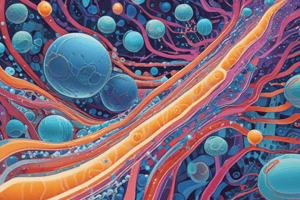Podcast
Questions and Answers
What is the primary difference between facilitated diffusion and active transport?
What is the primary difference between facilitated diffusion and active transport?
- The energy requirement for the process (correct)
- The type of molecules being transported
- The direction of movement of molecules
- The polarity of the molecules being transported
Which of the following processes is most closely related to the movement of water molecules?
Which of the following processes is most closely related to the movement of water molecules?
- Simple diffusion
- Active transport
- Facilitated diffusion
- Osmosis (correct)
What is the purpose of facilitated diffusion in a cell?
What is the purpose of facilitated diffusion in a cell?
- To increase solute concentration
- To regulate ion balance (correct)
- To transport large molecules
- To maintain cell membrane structure
Which of the following processes requires a transport protein?
Which of the following processes requires a transport protein?
What is the net result of osmosis on a cell?
What is the net result of osmosis on a cell?
Flashcards are hidden until you start studying
Study Notes
Cell Transport Mechanisms
- The primary difference between facilitated diffusion and active transport is the direction of concentration gradient and energy requirement: facilitated diffusion moves molecules from high to low concentration without energy input, whereas active transport moves molecules from low to high concentration using energy.
Osmosis
- Osmosis is the process most closely related to the movement of water molecules, which helps to equalize solute concentrations between two solutions.
Facilitated Diffusion
- The purpose of facilitated diffusion in a cell is to speed up the movement of molecules down their concentration gradient, increasing the efficiency of essential cellular processes.
Transport Proteins
- Facilitated diffusion requires a transport protein, which forms a channel or binds to the molecule, allowing it to pass through the cell membrane.
Effects of Osmosis
- The net result of osmosis on a cell can be isotonic (no change in cell shape), hypertonic (cell shrinks), or hypotonic (cell swells), depending on the solute concentrations inside and outside the cell.
Studying That Suits You
Use AI to generate personalized quizzes and flashcards to suit your learning preferences.




